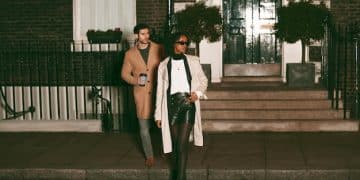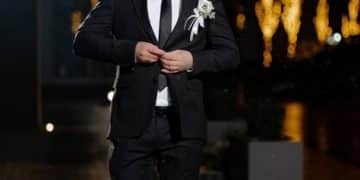The Little Black Dress: A Style Icon Through the Decades
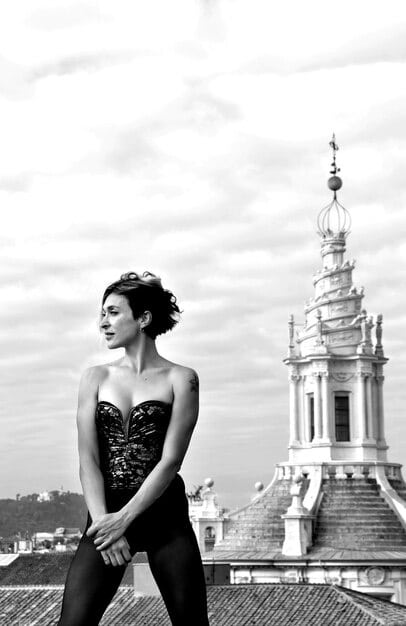
Anúncios
The little black dress has transcended mere clothing to become a timeless emblem of sophistication and versatility, its enduring appeal woven through fashion history as a testament to its adaptive and universally flattering design across diverse eras.
Few garments possess the universal appeal and enduring legacy of the little black dress: a style icon through the decades. Far more than a simple attire choice, it represents a potent symbol of elegance, rebellion, and confidence that has graced countless wardrobes for nearly a century. From its groundbreaking debut to its continuous evolution on runways and red carpets worldwide, this sartorial staple has proven its remarkable ability to adapt while maintaining its core essence of understated chic.
Anúncios
The Genesis: Chanel’s Vision and the Roaring Twenties
The story of the little black dress (LBD) truly begins with its formal introduction to the fashion world by Gabrielle “Coco” Chanel in 1926. While black garments existed before, Chanel took a bold step by proposing a simple, unadorned black crêpe de Chine dress as a universal uniform for all women, accessible across social classes. This vision was revolutionary in an era dominated by opulent, restrictive fashion typical of the pre-World War I period.
Chanel’s design was initially met with some skepticism but quickly gained traction. Vogue magazine, a powerful voice in fashion, published an illustration of Chanel’s LBD in 1926, referring to it as “Chanel’s Ford” – a nod to Henry Ford’s T-model car, suggesting its ubiquity and universal appeal. This comparison perfectly encapsulated the democratic and revolutionary spirit of the LBD: it was meant to be practical, versatile, and stylish for the modern, independent woman. The dress broke away from the tradition of color-coded mourning wear, transforming black into a symbol of smart sophistication.
Anúncios
Revolutionizing Women’s Fashion
The LBD emerged during a time of immense social change, particularly for women. The Roaring Twenties saw women gaining more freedom, politically and socially. They discarded corsets, cropped their hair, and embraced more active lifestyles. The simple, straight lines and comfortable fit of Chanel’s LBD perfectly aligned with this newfound liberation, allowing women to move freely and express a more streamlined, modern aesthetic. It was not just a dress; it was a statement of independence.
The dress offered an unprecedented level of versatility, easily adaptable from day to night with simple changes in accessories. This adaptability made it an economic choice for many women, who could achieve multiple looks with one fundamental garment. It democratized style, bringing chic into the reach of broader segments of society. The LBD was truly a symbol of its time, capturing the essence of an evolving female identity and anticipating the needs of modern life.
- 👗 Empowered women with a practical and stylish choice.
- 🖤 Transformed black from mourning to chic elegance.
- 🌐 Offered universal appeal beyond class distinctions.
The Golden Age of Hollywood: Glamour and Mystique (1930s-1950s)
As the world entered the era of the Great Depression, fashion’s focus shifted towards more practical, yet still glamorous, styles. The little black dress continued its reign, often seen as a symbol of practical elegance in austere times. Hollywood played an instrumental role in solidifying the LBD’s iconic status, giving it a new layer of allure and mystique. Actresses like Bette Davis and Joan Crawford frequently wore LBDs on screen, cementing its association with sophistication and power.
During the 1940s, wartime austerity influenced fashion, leading to simpler silhouettes and practical designs. The LBD, with its inherent simplicity and adaptability, fit perfectly into this landscape. It became a reliable choice for women entering the workforce or participating in wartime efforts, offering decorum without flashy extravagance. Post-war, as women embraced new freedoms, the LBD evolved, reflecting the changing desires for both comfort and renewed glamour.
Audrey Hepburn and the “Breakfast at Tiffany’s” Effect
The 1960s ushered in a new golden era for the LBD, largely due to Hubert de Givenchy’s iconic design for Audrey Hepburn in the film “Breakfast at Tiffany’s” (1961). This particular LBD, a slim-fitting, floor-length gown with understated elegance, instantly became a global fashion phenomenon. It was simple, yet profoundly sophisticated, epitomizing effortless glamour. This dress, perhaps more than any other single design, cemented the LBD’s place in the collective consciousness as the epitome of chic.
Hepburn’s portrayal of Holly Golightly, with her nonchalant elegance and a string of pearls, made the LBD synonymous with sophisticated charm. The dress was not just part of her costume; it was an integral part of her character’s identity, symbolizing her enigmatic allure. The influence of this film extended far beyond fashion, permeating popular culture and inspiring countless imitations and interpretations. It showed the world that a black dress could be both understated and breathtakingly beautiful, proving its versatility from casual chic to haute couture.
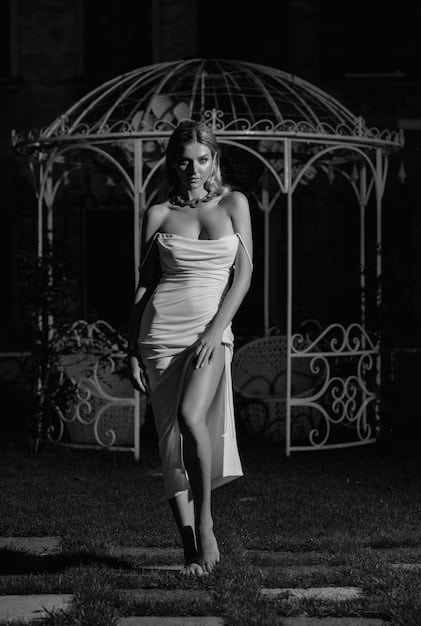
- 🎬 Hollywood’s embrace elevated the LBD’s status.
- 💎 Audrey Hepburn’s Givenchy LBD became legendary.
- ✨ Symbolized sophisticated charm and cinematic allure.
Modern Transformations: From Punk to Power (1970s-1990s)
The 1970s brought forth a wave of counter-cultural movements, and fashion embraced diverse styles, from bohemian to disco. The LBD, ever adaptable, found new expressions. Designers like Yves Saint Laurent continued to champion its elegance, offering versions that embodied a more relaxed yet still polished aesthetic. However, it was arguably the punk movement of the late 70s and early 80s that pushed the LBD into unexpected territories, subverting its traditional elegance.
Punk transformed the LBD into something rougher, edgier, and defiant. Styled with ripped stockings, safety pins, and heavy boots, it became a symbol of rebellion and anti-establishment sentiment. This appropriation demonstrated the LBD’s incredible elasticity – its ability to be reinterpreted and recontextualized across drastically different subcultures without losing its fundamental identity as a black dress. This period highlighted the LBD’s capacity to be both conservative and revolutionary, depending entirely on its styling.
The Rise of Designers and Power Dressing
The 1980s saw the emergence of “power dressing,” where women used clothing to assert authority in professional environments. The LBD, with its inherent seriousness and sophistication, became a key component of this trend. Designers like Donna Karan specifically created LBDs designed for the working woman, combining comfort with boardroom-ready elegance. These were often more structured, sometimes with shoulder pads, reflecting the decade’s iconic silhouette of strength and confidence.
By the 1990s, minimalism took center stage, and the LBD perfectly aligned with this pared-down aesthetic. Designers embraced clean lines, simple cuts, and luxurious fabrics, allowing the LBD to shine in its purest form. Fashion houses like Calvin Klein and Helmut Lang offered sleek, unadorned black dresses that were both understated and incredibly chic, reflecting a shift away from overt maximalism. This era showcased the LBD’s capacity for quiet sophistication, proving that less could indeed be more in terms of impactful style. Princess Diana’s “revenge dress” in 1994, a daring off-the-shoulder LBD, famously showcased its power to convey a powerful message without words.
Contemporary Interpretations: Redefining Versatility (2000s-Present)
The turn of the millennium brought an even greater diversification of fashion trends, leading to a constant reinterpretation of classic styles. The little black dress, far from becoming an relic, embraced this fluidity. Designers often experiment with new fabrics, innovative cuts, and unexpected embellishments, ensuring the LBD remains current and exciting. From edgy streetwear adaptations to high-fashion avant-garde creations, its form continues to evolve while its essence remains constant.
Today, the LBD is seen on everyone from royalty to pop stars, demonstrating its incredible range. Designers are exploring sustainability in fashion, leading to LBDs made from eco-friendly materials or upcycled fabrics. This aligns with a growing consumer consciousness that values not just style, but also ethical and environmental impact. The LBD serves as a canvas for these changing values, adapting its construction and materials to meet contemporary demands.
The LBD as a Staple in Every Wardrobe
The contemporary fashion landscape celebrates individuality and personal style, and the LBD perfectly facilitates this. It serves as a foundational piece, allowing wearers to inject their personality through accessories, layering, and varied styling. Whether it’s a casual daytime look with sneakers and a denim jacket, or a glamorous evening ensemble with high heels and statement jewelry, the LBD provides an adaptable base. Its timelessness means it transcends fleeting trends, making it a reliable investment for any wardrobe.
Social media and celebrity culture continue to play a role in its prominence. Every season, new iterations of the little black dress appear on runways and are then quickly adopted by influencers and famous personalities, inspiring millions. The accessibility of fashion information means that classic pieces like the LBD are constantly being rediscovered and reinterpreted by new generations, ensuring its continued relevance. It’s a garment that bridges generations and style preferences, a true testament to its universal appeal.
- 💡 Constant innovation in fabric and cut keeps it fresh.
- ♻️ Adapts to new trends like sustainability and individuality.
- 👗 Remains a versatile cornerstone for personal styling.
The Enduring Appeal: More Than Just a Dress
The longevity of the little black dress goes far beyond its simple design or color. Its enduring appeal lies in a confluence of factors that tap into fundamental human desires: elegance, confidence, and versatility. It is a garment that promises to be appropriate for almost any occasion, providing a sense of reassurance in an ever-changing fashion landscape. This inherent reliability makes it a go-to choice for countless women worldwide.
Its ability to act as a blank canvas is another key to its success. The LBD doesn’t overpower the wearer; instead, it allows her personality and the chosen accessories to shine. This subtly empowering quality distinguishes it from other garments that might demand more attention. It’s a supportive piece that elevates, rather than dominates, the wearer’s style. This principle of understated elegance has made it indispensable in fashion.
A Symbol of Empowerment and Choice
From its inception, the little black dress represented a departure from restrictive fashion, offering women freedom of movement and a sense of liberation. This legacy of empowerment continues. Choosing an LBD often signifies confidence and a deliberate sense of style, without the need for ostentation. It allows women to feel polished and put-together with minimal effort, projecting an image of effortless chic.
The LBD also serves as a potent symbol of fashion’s cyclical nature and its capacity for reinvention. Each decade adds its unique imprint, yet the core identity of the black dress remains intact. It demonstrates how a simple concept, when perfectly executed, can transcend time, trends, and cultural shifts to become a permanent fixture. Its presence in high fashion, celebrity culture, and everyday wardrobes confirms its status not just as a dress, but as a living legend in the annals of style.
Styling Your Little Black Dress: Timeless Tips
The true beauty of the little black dress lies in its remarkable versatility, allowing for a multitude of styling options that can adapt it to any occasion, mood, or personal aesthetic. Understanding how to maximize its potential is key to unlocking its full iconic status in your wardrobe. The right accessories can transform a simple LBD from a casual daytime staple into a show-stopping evening gown, illustrating its chameleon-like quality.
When approaching the styling of your LBD, consider the event, your personal comfort, and the message you wish to convey. For a daytime look, think about pairing it with comfortable flats or stylish sneakers, a denim jacket, or a lightweight cardigan. A tote bag and minimal jewelry can complete a chic, effortless ensemble suitable for errands or a casual lunch. The focus here is on comfort and understated elegance.
Elevating for Evening Attire
Transitioning your LBD for an evening event is where its transformative power truly shines. Heeled shoes, whether stilettos or elegant block heels, instantly elevate the silhouette. Statement jewelry – a bold necklace, dazzling earrings, or an armful of bracelets – can add a touch of glamour. A clutch bag, perhaps in a contrasting color or with striking embellishments, serves as a refined complement.
Consider the interplay of textures: a sleek satin LBD paired with a velvet clutch, or a matte black dress with a shimmering sequined jacket. These textural contrasts add depth and sophistication without overpowering the black. A touch of red lipstick or a classic smokey eye can further enhance the evening look, adding a pop of color and definition. The LBD provides the perfect backdrop for personal expression through such styling choices.
- 💍 Accessorizing is key to transforming the look.
- 👠 Heels and statement jewelry elevate for evening.
🎨 Play with textures and makeup for added elegance.
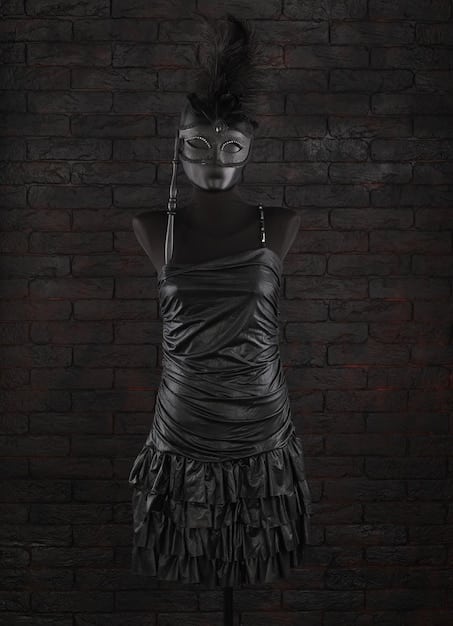
The Future of the LBD: Sustainability and Innovation (2020s and Beyond)
As the fashion industry grapples with pressing issues of sustainability and ethical production, the little black dress is once again proving its adaptability. Designers are increasingly focused on creating LBDs that not only look good but also align with environmentally conscious principles. This involves exploring innovative materials, promoting circular fashion, and emphasizing durability—qualities that the LBD intrinsically embodies due to its timeless nature.
We are seeing a movement towards slow fashion, where consumers invest in high-quality, versatile pieces that will last for years, rather than succumbing to fast fashion trends. The LBD fits perfectly within this paradigm, as a garment that rarely goes out of style. Its inherent longevity makes it a sustainable choice, reducing textile waste and promoting a more mindful approach to consumption.
Technological Advancements and Customization
The future of the LBD might also incorporate technological advancements, from smart fabrics that adapt to body temperature to custom-fit 3D printing. As personalization becomes more prevalent, imagine an LBD perfectly tailored to your measurements and preferences, perhaps even incorporating subtly integrated tech features. This blending of classic design with futuristic innovation could open new frontiers for this iconic garment.
Furthermore, the LBD continues to be a canvas for artistic expression. We can expect to see designers experimenting with more avant-garde silhouettes, incorporating gender-fluid designs, or utilizing cutting-edge embellishments. Its simplicity allows for endless creativity, ensuring it remains at the forefront of fashion. The LBD is not just a relic of the past; it is a dynamic, evolving icon ready to embrace the challenges and innovations of the fashion world of tomorrow, solidifying its place as a cornerstone for generations to come, truly making it a style icon through the decades.
| Key Aspect | Brief Description |
|---|---|
| 👗 Fashion Innovation | Revolutionized women’s wear, introducing a versatile, accessible staple. |
| 🎬 Cultural Impact | Cemented by Hollywood icons like Audrey Hepburn. |
| 🔄 Adaptability | Transforms from punk rebellion to minimalist chic across eras. |
| 🌿 Future Trends | Embracing sustainability and technological integration. |
Frequently Asked Questions About The Little Black Dress
Gabrielle “Coco” Chanel is widely credited with popularizing the modern little black dress (LBD) in 1926. Her simple, unadorned design was featured in Vogue magazine, which lauded it as a universal uniform akin to Henry Ford’s Model T, emphasizing its democratic and widespread appeal.
The LBD’s versatility stems from its classic black color and often simple silhouette, allowing it to be easily dressed up or down with accessories. It can transition effortlessly from casual daytime wear with flats to formal evening attire with heels and statement jewelry, making it suitable for numerous occasions and styles.
Hollywood significantly boosted the LBD’s iconic status, particularly with Audrey Hepburn’s Givenchy dress in “Breakfast at Tiffany’s” (1961). Actresses frequently wore LBDs on screen, associating them with glamour, sophistication, and timeless elegance, which deeply influenced public perception and desire for the garment.
The LBD has adapted by adopting various silhouettes, fabrics, and embellishments reflecting each decade’s trends. From the flapper style of the 20s to the minimalist lines of the 90s, and even punk adaptations, its core black color and inherent chicness allowed it to remain relevant while evolving with the times.
Absolutely. The LBD remains a cornerstone of modern fashion. Its timeless appeal, adaptability to new trends like sustainability, and ability to serve as a versatile foundation for personal styling ensure its enduring relevance. It continues to be a staple in wardrobes worldwide, constantly reinterpreted by designers and wearers.
Conclusion: The Undying Legacy
The little black dress has proven itself to be far more than a fleeting fashion trend; it is a permanent fixture in the annals of style. From its groundbreaking origins in the Roaring Twenties championed by Coco Chanel to its cinematic apotheosis with Audrey Hepburn, and its continuous evolution through punk, power dressing, and contemporary minimalism, the LBD has consistently adapted while retaining its core identity of elegance and versatility. Its enduring appeal lies in its ability to empower, simplify, and elevate, offering a canvas for personal expression that transcends trends and generations, solidifying its place as a truly timeless icon.

